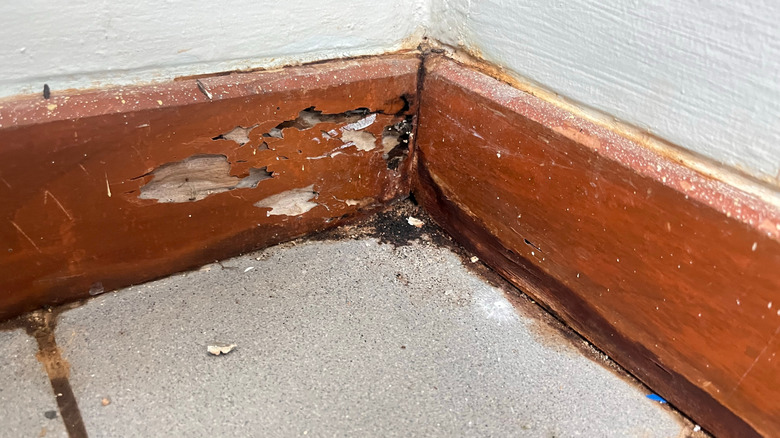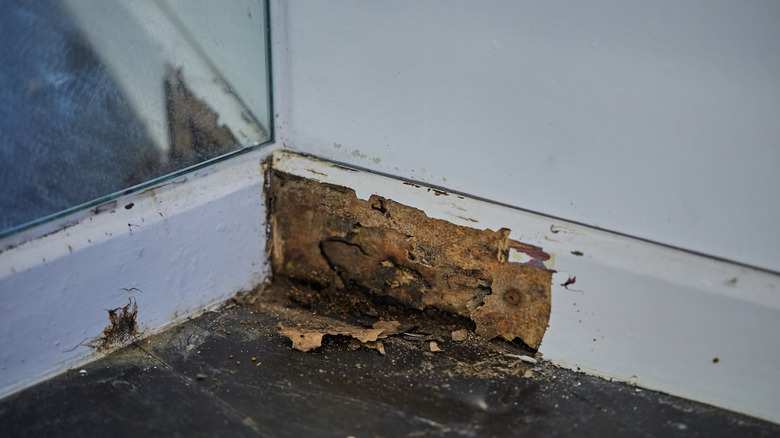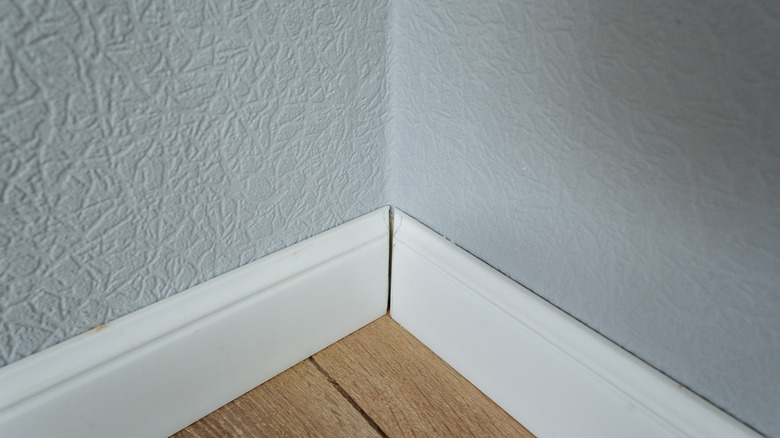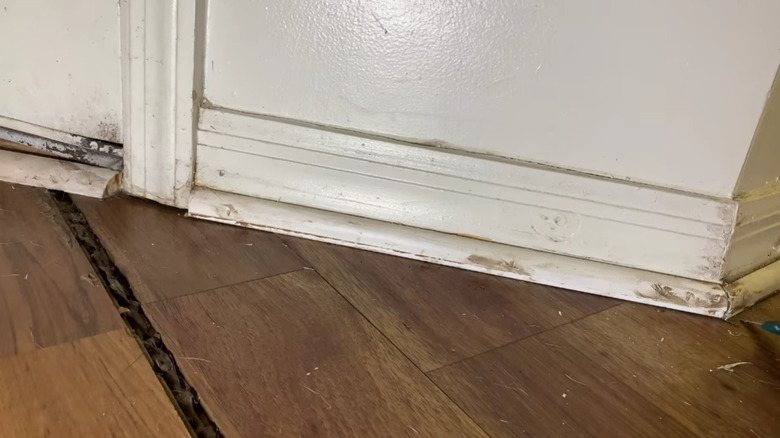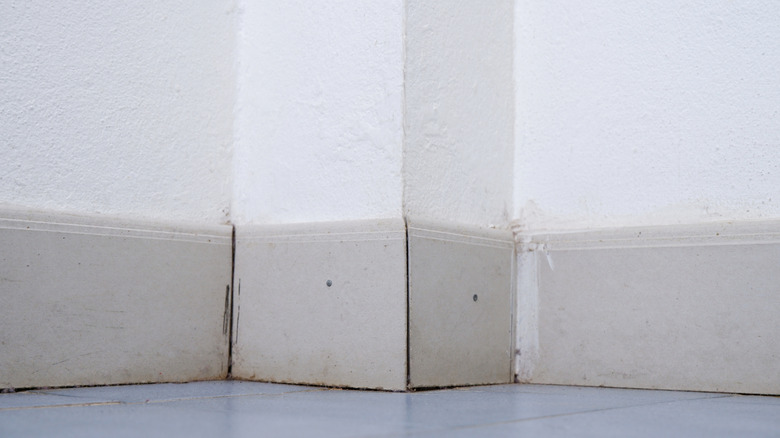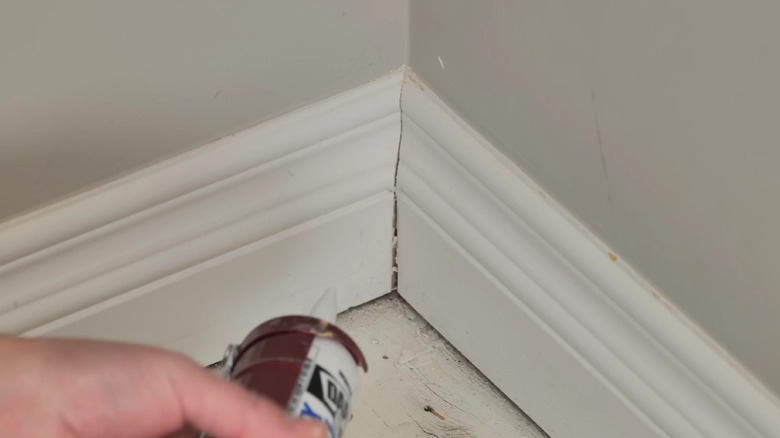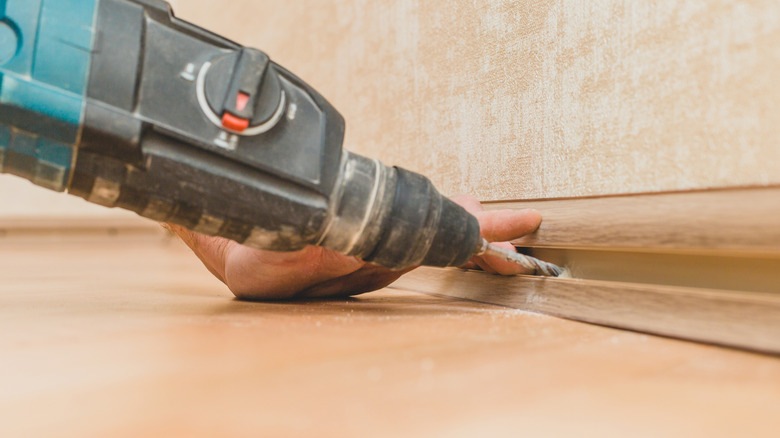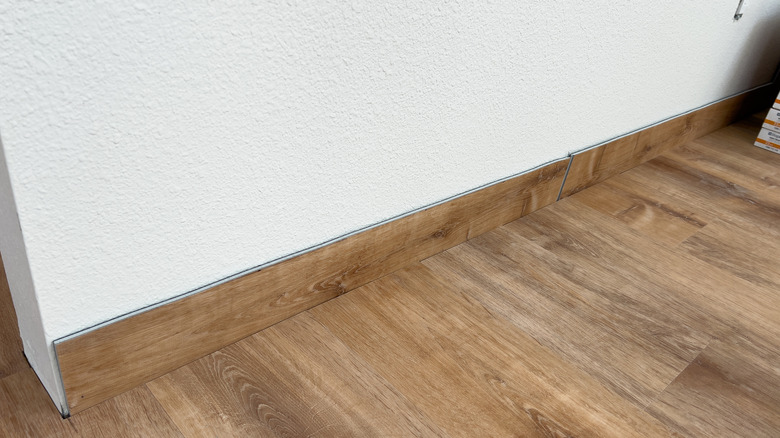11 Signs You Can't Ignore That It's Time To Replace Your Baseboards
Baseboards are so easy to overlook as just decorative trims in a room; however, they do serve a critical function in your home. Baseboards are the board or trim that runs along where the wall meets the floor, providing an essential barrier to seal that angled joint, protecting the bottom of the plaster or drywall from getting torn up by daily wear. Not only do they protect the ends of the wall, but good baseboards are also vital for maintaining a clean environment, as they seal off the wall from dust, pests, moisture, and dirt. Furthermore, baseboards actually help regulate temperature, stopping drafty air flows that could otherwise make your house hotter during the summer or colder during the winter; they help overall energy efficiency since you don't have to manipulate your environment with heaters or air conditioners.
Given how important baseboards' functions can be, you should always check baseboards before purchasing a new home and should make it a habit to regularly check on them throughout your home. When you know what to look for, the signs will make themselves pretty clear as to the health of those pieces on the walls. At a certain point in time — whether it be the baseboards obviously bulging, feeling spongy to the touch, or gapping irregularly — you can't ignore that it's time to replace your baseboards. If you're not careful, it can get worse, so be sure to address it as soon as you can!
Rotting wood
Rotting baseboards aren't just a cosmetic issue; they're likely pointing to an underlying moisture problem caused by fungi or mold present within wooden baseboards, which itself is typically an indication of a leak. Wood rot and decay on the baseboards are just the tip of the iceberg, signaling water intrusion behind or within the walls, as well as potential mold inside the wall. Since rot from moisture can spread and further compromise the structural integrity of the home, replacement is key. Remember to identify and remediate the source of water before fixing the baseboards for long-term care.
Pest damage
Baseboards are one of the most visible spots where hidden pest infestations can make themselves known. Termites especially use the baseboard and the wall-to-floor joint to craft mud tubes – tunnels that facilitate entry into the wall, subflooring, and other structural wood elements. The damage you see on baseboards — like soft, peeling wood and tiny exit holes — means the pests have succeeded in creating runs and tunnels inside the baseboard and elsewhere. Removing and replacing the baseboards is essential here so that you can fully assess the damage to the structure and ensure extermination of the pests.
Poor installation
Poorly installed baseboards are a significant issue both aesthetically and functionally, and while you may think you can ignore them because they're cosmetic, think again! Misaligned joints and visible gaps between the trim pieces or the wall and floor create not only a messy appearance, but these gaps can also compromise insulation. Such gaps allow for drafts, dust, dirt, and even pests to enter the room. In damp areas, gaps can also trap moisture, leading to potential mold or mildew issues. Consider replacing poorly installed baseboards if the issues are severe, including large, unmanageable gaps or even broken pieces.
Bubbling or bulging
Speaking of potential water damage, bulging baseboards are another clear indication of a serious moisture problem that'll necessitate immediate replacement. This kind of swelling points to an absorption of excessive water, causing the baseboard material — often MDF (medium-density fiberboard) or wood — to expand and warp. It's a visible warning that the wall or underlying structure is likely compromised and may be harboring humidity or even toxic mold. Repairing bubbling baseboards is likely not possible once the material is saturated, meaning replacement will be necessary once the moisture has been mitigated.
Too many layers of paint
While repainting baseboards is a way to save money during a home upgrade, excessive layers of paint are detrimental since a thick build-up of paint makes the baseboard prone to issues that otherwise wouldn't exist. Over time, the layers expand and contract at different rates, leading to unsightly cracking and peeling that's difficult to fix without fully stripping the boards (there's a wrong and right way to strip paint from wood, by the way). Replacement is a less arduous fix and ensures that your baseboards are properly sealed from moisture issues, something that paint can also hide.
Mold or mildew
The presence of mold on your baseboards is a critical visual cue that there are likely long-standing, severe moisture issues. Mold spores grow on wet surfaces and thrive in dark, warm, and damp environments, eating organic substances like wood. While you may think cleaning mold off of baseboards is enough to get rid of it, mold can penetrate deep into the baseboard itself, and any remaining spores can continue to impact air quality in the home.
Lifting or warping
Warping or lifting baseboards is another critical sign that the trim is experiencing some sort of structural failure, and it'll require replacement to restore the seal between the walls and floors that baseboards create. This sort of damage primarily occurs due to prolonged exposure to moisture or extreme temperature fluctuations. While it also may be a sign of faulty installation, failure to replace it means the baseboard can no longer effectively seal the joint between the wall and the floor. The gap created by lifting allows moisture, pests, and dust to get into the walls.
Cracked caulking
While cracks seen within the caulking of baseboards aren't an indicator of immediate replacement, it's what happens when you try to fix the crack that can be a sign that a replacement — or an even bigger structural project — is necessary. Often, cracked caulking is evidence of poor execution, newer construction settling, or simply seasonal movement of the framing; however, if you know you caulked your baseboards like a pro, and the caulk still immediately fails when reapplied, then there may be a bigger, more serious structural issue to deal with.
Excessive holes or divots
Another indication that baseboards need replacement is the buildup of numerous holes or divots caused by cable installation or poorly executed installation or repair of the baseboard itself. While minor nail holes are common and easily patched (though even then, there comes a time when the patches could fail), repeated holes can attract and collect dust and debris — and sometimes even moisture. If the holes expand with humidity, for example, it can lead to cracks and further damage in the baseboard itself, so get ahead of a potentially bigger issue and replace holey baseboards.
Chipping paint and scratching
While minor scuffs to paint can be repaired and repainted, continued chipping or peeling paint on baseboards points to a couple of major issues that necessitate replacement. First, it can signal our biggest villain on this list: moisture intrusion. This will cause the baseboard to lose its structural bond with the paint. Second, it can indicate an adhesion issue across the entire board, often due to an underlying problem like incompatible paint materials. In both cases, simply painting over the issue is only a band-aid to bigger concerns, and eventually, the baseboard material will continue to fail.
Incorrect or unusual materials
Using the wrong material is not only an aesthetic issue; in the long run, it can necessitate a bigger (and probably pricier) change. In the short term, it may seem like a clever DIY that uses leftover materials; however, this choice can lead to a number of environmental issues. Incongruous material is not equipped to handle the rigors of baseboards, and its vulnerabilities make it a perfect breeding ground for mold, dust, moisture, and other issues. If you see your home has these hodge-podge fixes, don't ignore them, and replace your baseboards before bigger issues arise.

